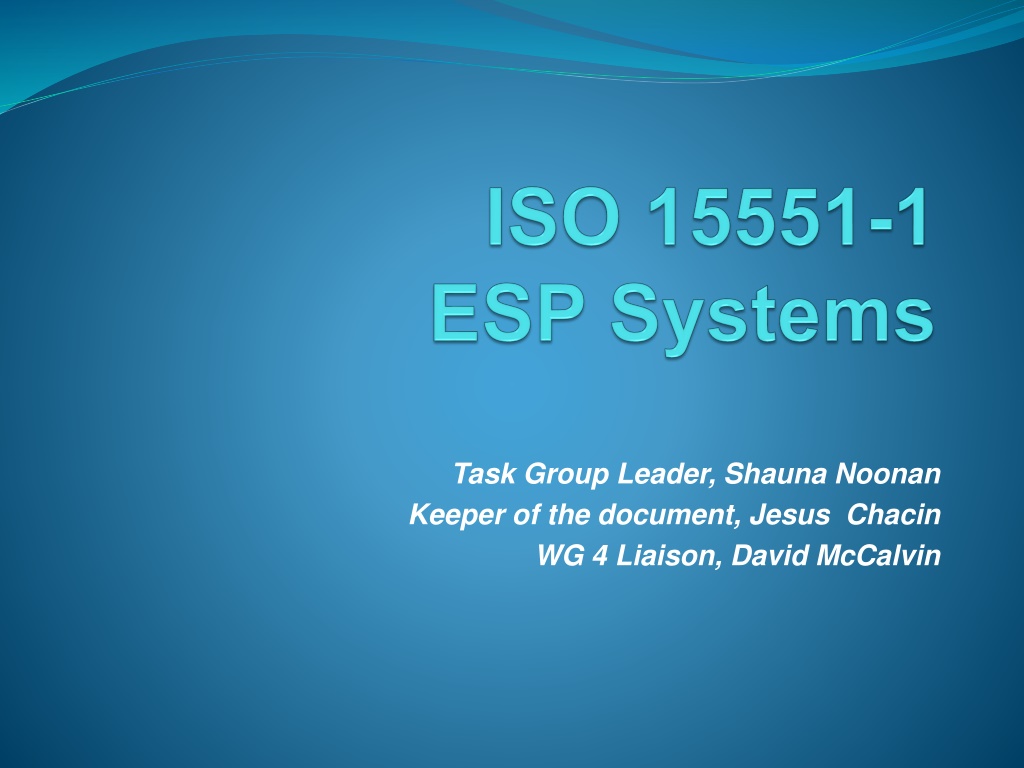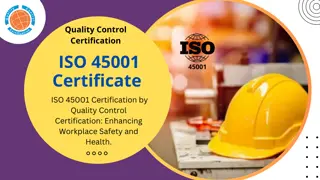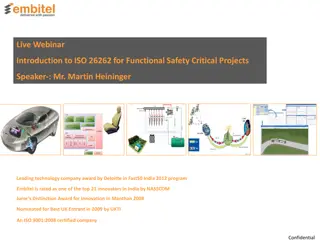Development of ISO Standard for Electrical Submersible Pump Systems
Task Group Leader Shauna Noonan leads a collaborative effort to draft an ISO standard for Electric Submersible Pump (ESP) systems in the petroleum and natural gas industry. The initiative responds to industry demands for flexible ESP specifications. The work group, comprising 16 members from major oil companies and document keepers, seeks to establish comprehensive standards covering design, manufacturing, performance evaluation, and repair of ESP systems.
Download Presentation

Please find below an Image/Link to download the presentation.
The content on the website is provided AS IS for your information and personal use only. It may not be sold, licensed, or shared on other websites without obtaining consent from the author. Download presentation by click this link. If you encounter any issues during the download, it is possible that the publisher has removed the file from their server.
E N D
Presentation Transcript
Task Group Leader, Shauna Noonan Keeper of the document, Jesus Chacin WG 4 Liaison, David McCalvin
Downhole equipment for petroleum and natural gas industries Electric submersible pumps NWI, approved 14 of 15 members approve d forming the work group to draft the standard, one did not vote BSN (Indonesia) In the voting process Brazil, China, France, Italy, UK, and US offered experts to participate In the balloting China also offered Refer to Chinese standard GB/T 16750-2008 (translation pending) and Provide methods and regulations to test all parts of ESP
General Background This effort is in response to repeated request by ESP experts in several major oil companies stating that ESP specifications were needed. Since ISO is more internationally accepted in the area of their operations, they initiated a new work proposal within the ISO system. Grades were needed within testing and manufacturing specifications to be flexible to end-user needs. Need a single standard that covers the entire ESP system was the interest of the 21 kick-off meeting attendees Initial meeting of the work group, 11/12 November 2009 in Houston
Members of the ESP work group (16) include representatives from: Schlumberger Centrilift Borets-Weatherford Woodgroup ESP ConocoPhillips ExxonMobil Shell Petrobras Oxy Chevron Statoil Total Nexen ENI (TBN) CNPC (TBN) CFER document keeper.
Scope of ISO 15551-1 (part 1) This part of ISO 15551 provides requirements for the design, design verification and validation, manufacturing and data control, performance ratings, functional evaluation, repair, handling and storage of the electrical submersible pump (ESP) systems for use in the petroleum and natural gas industry. This part of ISO 15551 is applicable to those components meeting the definition of centrifugal pumps including gas handling devices, discharge heads, seal sections, intake systems, gas separators, induction motors, motor lead extension and potheads, and power cables. - Industry standards or RPs do not exist on the testing of these components, to our knowledge.
Scope of ISO 15551-1 (part 2) This International Standard includes normative annexes that establish requirements for: component design validation, application verification and functional evaluation. Additionally, informative annexes address ESP sizing, application and equipment selection guidelines, repair and reconditioning methods, system testing, analysis after use, and auxiliary equipment, surface power systems. (installation and operation) Equipment not covered by the requirements of this part of ISO 15551 includes: motor and pump shrouds, motor oil filters, electric penetrators and feed- through system, cable clamps and banding, centralizers, intake screens, by- pass tools, check and bleeder valves, component adaptors, capillary lines, and permanent magnet motors. These items may or may not be covered by other standards
Which API documents will be most affected by ISO 15551? 11S: RP for Operation, Maintenance and Troubleshooting of ESPs ISO 15551-1 is envisioned to include requirements that will make these documents outdated. It is recommended that API postpone work on these RPs until ISO 15551-1 is complete to make the decision to adopt it . 11S1: RP for ESP Teardown report 11S2: RP for ESP Testing 11S3: RP for ESP Installations 11S4: RP for Sizing and Selection of ESP Installations 11S5: RP for Application of ESP Cable Systems 11S6: RP for Testing of ESP Cable 11S7: RP on Application and Testing of ESP Seal Chamber Sections 11S8: RP on ESP System Vibration
How can API work on their revisions in compliment to ISO? It is recommended that the API group focus on revisions of 11S, 11S3 and 11S4. Those documents can be informative references in the ISO standard and David McCalvin thinks that perhaps ultimately, all three can be combined into one ISO document (possibly 15551-2: ESP Selection, Installation and Troubleshooting). It is also recommended that the API group focus on cable and the revisions of 11S5 (Cable applications) and 11S6 (Cable testing). This can also be made into a separate ISO document upon completion (possibly 15551-3: ESP Cable Applications and Testing). With this method the API and ISO sets of standards are realized by the industry as complementary, we are working with the API team to ensure this flows smoothly.
ISO 15551-1 is proceeding quickly First meeting was held November, 2009. Draft on technical and user specifications was targeted for January 15th , 2010. Committee met to discuss motor ratings on January 19th, 2010. Draft to be reviewed and expanded during next committee meeting in Aberdeen on February 13-14th. At least two other meetings are scheduled in 2010. We are targeting August 2011 as our first draft to CD date, this maybe a bit optimistic but tight goals keep the process moving, none of the work group members have time to waste.
on the road towards becoming a standard























